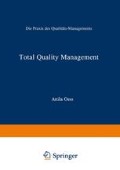Zusammenfassung
Die Japaner setzen die Geburt der Quality Circles auf das Jahr 1962 an, als die Herausgeber der Zeitschrift „Statistical Quality Control“ beschlossen, ein Schwesterblatt mit dem Namen „gemba-to-QC“ (Qualitätssicherung für Meister) zu gründen. In der ersten Ausgabe im April 1962 wurde zur Gründung von Quality Circles aufgerufen. Zur gleichen Zeit organisierten die Herausgeber dieser Zeitschrift die Zentrale für Quality Circles, um die Registrierung von derartigen Gruppen zu ermöglichen und die Idee zu propagieren2.
Access this chapter
Tax calculation will be finalised at checkout
Purchases are for personal use only
Preview
Unable to display preview. Download preview PDF.
Literatur
Die Japaner sprechen nicht von Quality Circle, sondern von Quality Control Circle.
Eine sehr detaillierte Übersicht über die Geschichte der Quality Circles findet sich bei: Engel, P.: „Japanische Organisationsprinzipien“, Zürich 1981.
Eine sehr gute deutschsprachige Übersicht über das Gesamtkonzept befindet sich in: Zink, K. J., Schick, G.: „Quality Circles. Problemlösungsgruppen. Qualitätsförderung durch Mitarbeitermotivation“ München 1984.
Ishikawa, K.:,What is Total Quality Control?“, op. cit., p. 138.
How to operate QC Circle Activities“, JUSE, Tokyo, 1985, p. 4.
BMW Lernstatt, München, 1983, p. 7.
ICL Quality Circles Handbook, 24. 11. 1985, p. 5.
Juran, J. M.: „International Significance of the QC Circle Movement“, Reports of Statistical Application Research, Vol. 25, No 2, Sept. 1978, JUSE, pp. 101–110.
Crocker, O. L.; Sik Leung Chiu, J.; Charney, C.: „Quality Circles“, New York, Bicester, Engl., 1984, pp. 37–45.
Goodfellow, M.: „Quality control circle programs — what works and what doesn’t“, in: Quality Progress, Aug. 1981, pp. 30–33.
Oess, A.: „Qualitätszirkel; Bestandsaufnahme vor dem Kongreß“, in: Congress und Seminar, 8 + 9, 16–19, 1983.
Dunkel, D. u. Hammer, O.: „Lernstatt — Zusammenarbeit und Arbeitsumfeld aktiv gestalten lernen“, 2. Deutscher Quality Circle Kongreß, Bonn 1983.
Mauch, H.: „Werkstattzirkel“, Quickborn 1981.
Hinz, H.: „Die japanische,Qualitäts-Revolution`“ in: „Die Neue Gesellschaft” 7, 1981, pp. 601–604.
Klaus, H.: „Es gibt realistische und begründete Gegenpositionen“, Interview mit H. Klaus, in: Die Mitbestimmung, Düsseldorf 11/87, p. 669.
Author information
Authors and Affiliations
Rights and permissions
Copyright information
© 1989 Springer Fachmedien Wiesbaden
About this chapter
Cite this chapter
Oess, A. (1989). Rolle und Bedeutung der Quality Circles (QC). In: Total Quality Management. Gabler Verlag, Wiesbaden. https://doi.org/10.1007/978-3-663-20150-2_9
Download citation
DOI: https://doi.org/10.1007/978-3-663-20150-2_9
Publisher Name: Gabler Verlag, Wiesbaden
Print ISBN: 978-3-409-13622-8
Online ISBN: 978-3-663-20150-2
eBook Packages: Springer Book Archive

